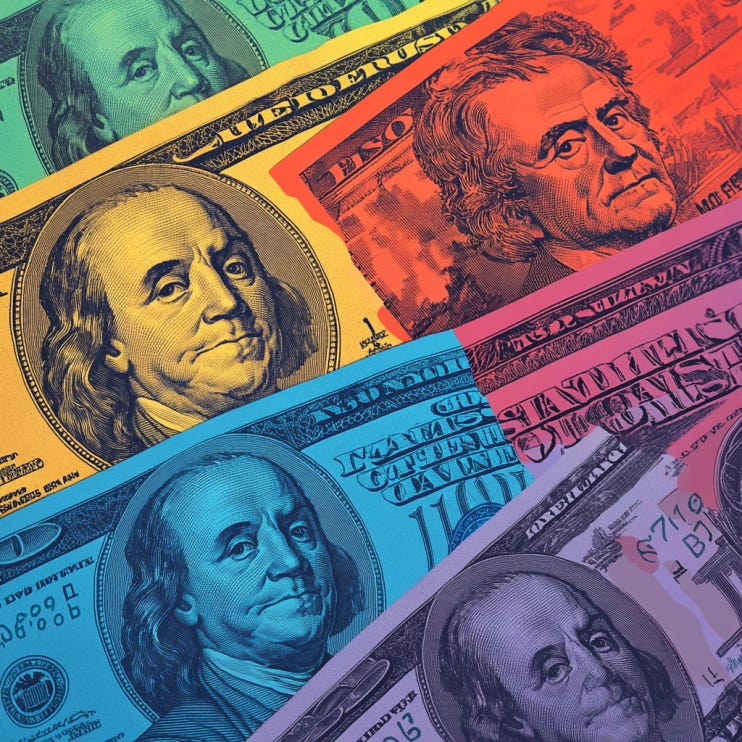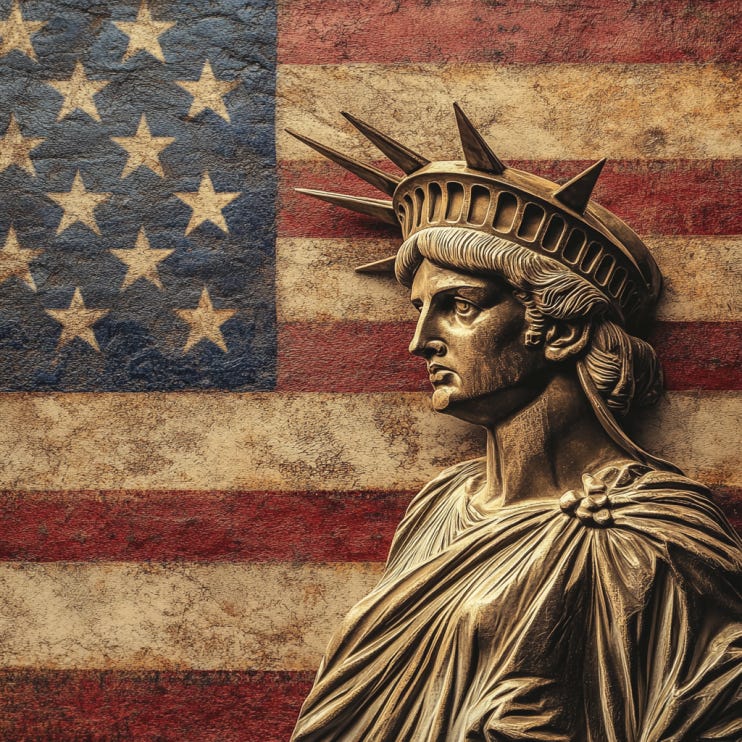Stablecoins Increase U.S. Dollar Strength as Global Reserve Currency: USDT & USDC
Many don't realize that USD-backed stablecoins like USDT & USDC enhance dominance of the U.S. Dollar
Stablecoins a.k.a. digital assets pegged 1:1 to fiat currencies - have grown rapidly, surpassing an estimated $206 billion in total market capitalization for January 2025. Tether (USDT) dominates the ecosystem with around $140 billion in market cap, making it the largest single stablecoin by a wide margin.
A key point is that over 90% of stablecoins in circulation track the U.S. dollar (USD). And rather than weakening the U.S. Dollar’s status, these “digital dollars” will have the opposite effect (increasing its strength).
For this reason, the U.S. government would be foolish not to embrace crypto stablecoins with clear regulation/legislation. Rolling out innovative USD stablecoins will boost USD dominance (relative to other global currencies) as a result of USD stability, trustworthiness, and first-mover advantage.
Related: Debunking the Myth: “Crypto Will Kill the Dollar”
Stablecoin Market Landscape (2025 Snapshot)
Overall Size and Growth
Total stablecoin market cap reached approximately $206 billion as of early 2025—having grown by an estimated 57% during 2024.
Daily trading volume often exceeds $100 billion, reflecting stablecoins’ centrality to crypto exchanges, DeFi protocols, and global payment flows.
Leading Stablecoins
Tether (USDT): ~$137B market cap (Jan 2025). Historically the most liquid stablecoin and most compatible across various blockchains.
USD Coin (USDC): ~$46B market cap (Jan 2025). Known for transparency and compliance, ranks second in market share.
PAX Dollar (USDP): ~93M market cap (Jan 2025). Affiliated with Paxos Trust Company.
Ripple USD (RLUSD): ~$64M market cap (Jan 2025). Affiliated with Ripple Labs (associated with XRP crypto). (Read: XRP Investment Analysis)
Gemini USD (GUSD): ~$58.4M market cap (Jan 2025). Affiliated with Gemini Exchange. Collateralized by USD held at State Street Bank.
Binance USD (BUSD): ~$60.5M market cap (Jan 2025) - affiliated with the cryptocurrency exchange Binance.
Primary Use Cases (Stablecoins)
Crypto trading pairs (on both centralized and decentralized exchanges).
Remittances and global B2B payments.
E-commerce settlements where merchants avoid high card fees (2–3%) by accepting stablecoins.
Storing value in places with high inflation or strict capital controls.
Stablecoin Growth Projections (2030-2035)
Even the lower-end scenarios project stablecoins continuing to expand rapidly, with USD-pegged tokens capturing the vast majority of market share.
Conservative Estimates
The total stablecoin market could surpass $1.1 trillion by around 2035, implying a compound annual growth rate (CAGR) near 18%.
Daily transaction volumes might reach $300 billion by late 2025—triple current levels—and steadily rise thereafter.
Bullish Outlook
Total stablecoin supply might surge to $3 trillion by 2030 in a favorable regulatory environment.
Annual stablecoin payment volumes could climb to $15 trillion by the same year, particularly if large-scale adoption occurs in e-commerce, DeFi, and cross-border remittances.
Stablecoin Regional Adoption Dynamics
Latin America & Sub-Saharan Africa
Fastest growth rates—exceeding 40% year-over-year.
Driven largely by inflation concerns, weak local currencies, and the need for cheaper remittances.
United States
Remains the largest stablecoin market overall due to established infrastructure and a relatively clearer (though evolving) regulatory framework.
U.S. banks and fintech firms increasingly partner with stablecoin issuers or create their own tokens, further embedding USD stablecoins in mainstream finance.
Global “Digital Dollarization”
Billions of unbanked or underbanked individuals worldwide can leapfrog local bank systems and adopt “digital dollars” for daily needs, from remittances to online purchases.
How Stablecoins Increase U.S. Dollar Dominance
It is highly logical to assume that compliant USD-backed stablecoins will dramatically increase global dominance of the U.S. Dollar.
1. Capital Inflows into Dollar-Denominated Reserves
1:1 Collateral: For each newly issued USD stablecoin, an equivalent amount of U.S. dollar–denominated reserves (e.g., Treasuries, cash in U.S. banks, money-market funds) must be held.
Scaling Effects: As circulation grows into the hundreds of billions or trillions, stablecoin issuers continuously purchase more short-term T-bills or deposit funds in American financial institutions. This raises foreign demand for U.S. assets, incrementally lowering Treasury yields.
2. Reduction in Payment Fees Drives More USD Usage
Lowering Transaction Costs: Accepting stablecoins allows merchants to bypass 2–3% card fees (e.g., Stripe, Visa) and settle transactions in minutes or seconds, 24/7.
Network Effects: As more businesses realize these savings, they encourage customers worldwide to pay in stablecoins—thus anchoring more transactions directly to the U.S. dollar, rather than local currencies.
3. Rapid Adoption in Volatile-Currency Regions
Safe Haven Demand: People living under hyperinflation or strict capital controls gravitate toward stablecoins to protect purchasing power.
“Digital Dollarization”: Where physical greenbacks were once prized, stablecoins now fill the same function—only more efficiently and securely via smartphones. This extends dollar usage far deeper into everyday life and commerce than in the past.
4. DeFi, E-Commerce, Tokenized RWAs
DeFi Protocols: Lending, borrowing, and yield-farming apps (e.g., Aave, Maker) heavily depend on dollar stablecoins for liquidity and risk management.
E-Commerce Expansion: From major online platforms to small web shops, global merchants are beginning to accept stablecoins to cut fees and instantly tap international markets—again raising the profile of USD as the default settlement currency online.
Tokenized Assets: As real-world assets (RWAs) get tokenized, stablecoins often serve as the trading pair, reinforcing the U.S. dollar as the “base layer” for tokenized finance.
When stablecoins scale, they inject unprecedented sums into U.S. Treasuries and dollar banking, while simultaneously offering merchants, consumers, and entire regions a simpler, cheaper path to dollar-based trade.
This dual effect—capital inflows plus expanded digital usage — further solidifies the U.S. dollar’s status as the world’s preeminent reserve currency.
How Much Stronger the Dollar Could Get from Stablecoins (Quantified Estimates)
The U.S. Dollar could get significantly stronger from stablecoin proliferation for many reasons.
1. Potential Treasury Yield Impact
From $206 Billion to $1–$3 Trillion: If stablecoin capitalization climbs from its current level ($206 billion) to roughly $1–$3 trillion by 2030, issuers must back these tokens with an equivalent amount in U.S. dollar–denominated assets.
Magnitude: An additional $800 billion to nearly $3 trillion flowing into Treasuries, money markets, and U.S. bank deposits.
5–10 Basis Points Yield Reduction: Even a modest 5–10 basis point (0.05–0.10%) drop in Treasury yields can save the government tens of billions of dollars annually on its multi-trillion-dollar national debt.
Relative Comparison: Currently, the U.S. pays hundreds of billions each year in interest. A 0.1% yield reduction may sound small, but on $25–$30 trillion in outstanding debt, it equates to sizable annual savings—potentially $25–$30+ billion more than at present rates.
2. E-Commerce & Payment Adoption
Cross-Border E-Commerce: Global online sales already approach the multi-trillion-dollar range annually. If stablecoins capture even a 10–20% slice of this pie, the U.S. dollar becomes a de facto settlement currency for hundreds of billions in digital transactions—significantly above current levels.
Daily Volumes: Stablecoin volumes could surpass $300 billion within a few years, much of it denominated in USD. This dwarfs today’s $100+ billion daily average, amplifying the dollar’s role in cross-border commerce.
Lowering Fees vs. Today’s Standards: Right now, merchants worldwide lose 2–3% per transaction to card fees. By adopting stablecoins, those overheads can drop to near-zero blockchain costs.
Outcome: A growing share of merchants and consumers default to using USD-based stablecoins for cost savings, further boosting overall dollar usage relative to present-day payment rails.
3. Global Economic Influence
Digital Dollarization: Hundreds of millions of potential new users—especially in high-inflation or underbanked regions—could switch from relying on local fiat to USD stablecoins for everyday transactions.
Comparative Shift: Today, many of these users have minimal exposure to the U.S. financial system. With stablecoins, they’re effectively “opting in” to the dollar economy, magnifying U.S. influence well beyond traditional banking markets.
Knock-on Effects: Each additional stablecoin user is one less person dependent on local currency for daily commerce. This “digital dollarization” enhances the greenback’s network effect and integrates more foreign markets with American monetary policy considerations.
Real-World Stablecoin Use Case: SpaceX’s Starlink
Starlink’s Stablecoin Payments: SpaceX’s satellite internet service uses stablecoins in underserved areas, sidestepping both currency volatility and high wire fees. Locals pay in stablecoins; Starlink automatically converts those holdings into USD in the U.S.
Why It Matters: Today, these same users might have dealt with inflated local currencies or patchy banks. By adopting stablecoins, they effectively adopt the U.S. dollar—deepening global reliance on the greenback.
Parallel Corporate Use: Global remittance providers, logistics platforms, and major software firms are similarly integrating stablecoins to avoid the inefficiencies of traditional banking rails. Each company doing so expands the scope of digital USD usage above and beyond current norms.
Major U.S. Companies Embracing Stablecoins
A wave of adoption is happening across financial services, tech, and traditional finance, propelling stablecoins—and by extension, the U.S. dollar—into everyday business transactions.
A.) Payment Companies
PayPal launched its own stablecoin (PYUSD) in partnership with Paxos, using it for some payroll and vendor payments, including demonstrations with large auditing firms.
Stripe acquired a stablecoin platform (Bridge) for over $1 billion to expand its capabilities in blockchain-based payments.
Visa invests in stablecoin projects and explores integrating stablecoins for real-time settlement.
B.) Banking & Financial Institutions
JPMorgan introduced JPM Coin for institutional settlements, already used by large firms for cross-border and intercompany transfers.
Circle issues USDC, known for frequent reserve attestations and transparency—second-largest stablecoin by market cap.
Tether remains the overall largest issuer, reportedly managing nearly $100 billion in U.S. Treasury bills at times.
C.) Investment Companies & Ventures
Researchers predict multiple stablecoin launches backed by major finance partnerships in the coming years.
Large asset managers like VanEck and BlackRock are engaging with stablecoin technology, potentially boosting institutional trust.
Robinhood is collaborating with Paxos on the Global Dollar Network.
World Liberty Financial (Donald Trump’s family venture) is developing a USD-backed stablecoin.
D.) Individual U.S. States
The state of Wyoming (arguably the most pro-crypto state) is developing a Wyoming Stable Token to be used for consumer payments.
The Wyoming Stable Token plans to launch in Q1 2025 and will be backed by short-term Treasury Bills.
USD-Backed Stablecoins: A Self-Reinforcing Engine for the U.S. Dollar
From a market of $206 billion in early 2025, stablecoins are on track to multiply in size—possibly exceeding a trillion-dollar milestone by 2030.
This explosion will cement the U.S. dollar as the primary store of value, medium of exchange, and reference currency within an increasingly digital, crypto-driven global economy.
From major corporations (PayPal, Stripe, Visa, JPMorgan) diving into stablecoin infrastructure to tech innovators (SpaceX Starlink) relying on “digital dollars” in underserved regions, USD-based stablecoins are becoming the global default for fast, low-fee, and borderless transactions.
The result is a self-reinforcing cycle:
More Stablecoins Minted → More Purchases of U.S. Reserves → Lower Treasury Yields & Higher USD Liquidity
More Businesses Adopt Stablecoins → Lower Fees, Faster Settlement → Stronger Preference for Digital Dollar Payments
Populations in Volatile Fiat Environments → Escape Inflation via USD Tokens → Greater Global Reliance on the Dollar
Future Projections: Even the most conservative scenarios show significant stablecoin expansion, with the U.S. dollar capturing most of the growth. Bullish scenarios—$3 trillion in stablecoin supply by 2030—would supercharge the dollar’s liquidity, soften Treasury yields, and elevate U.S. monetary dominance across all markets.
Clear regulation and industry collaboration will accelerate stablecoin innovation, locking in the U.S. dollar as the global reserve currency in an increasingly tokenized economy.
If current momentum holds, USD stablecoins may be remembered as the financial catalyst that transformed the greenback into a truly borderless, internet-native form of money—supercharging America’s economic clout well into the future.







